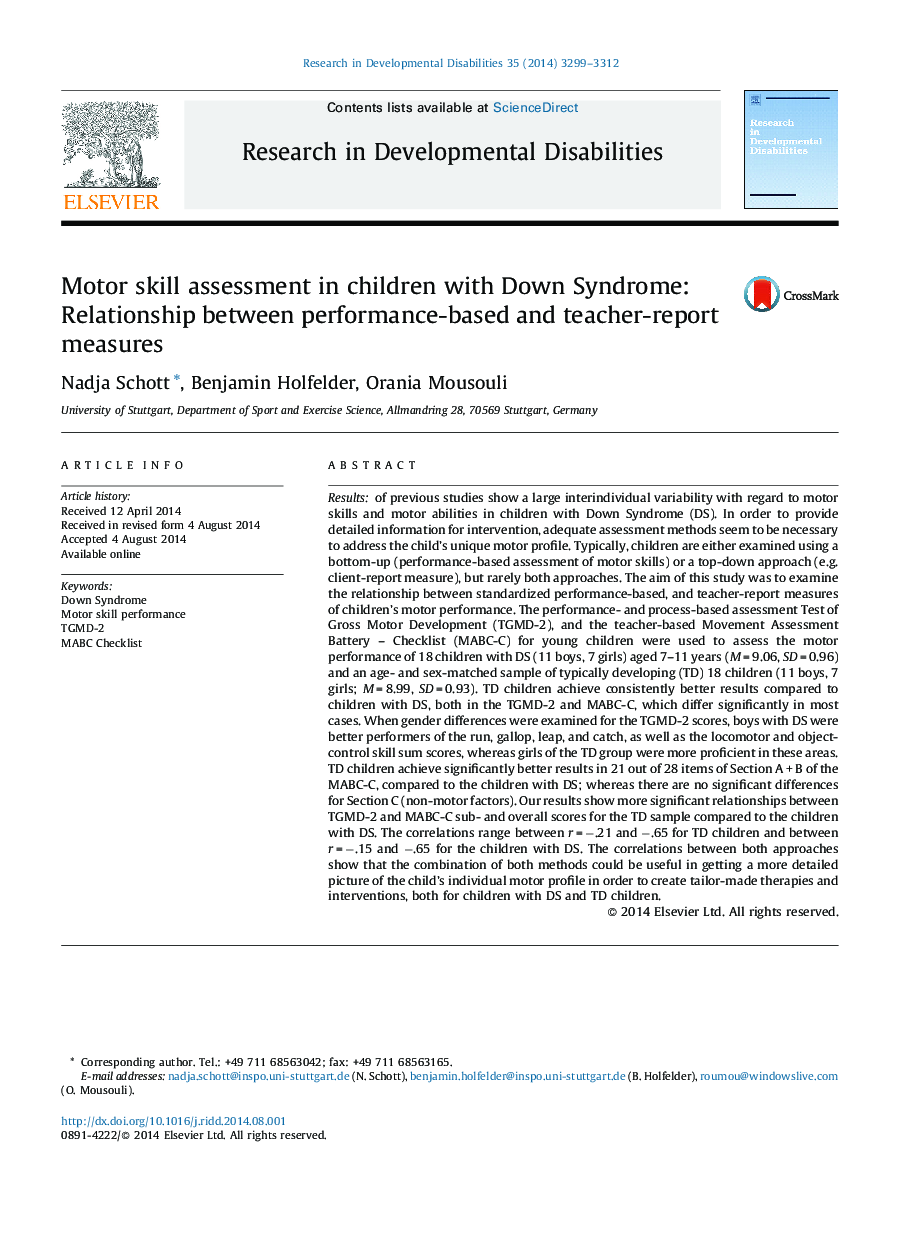| کد مقاله | کد نشریه | سال انتشار | مقاله انگلیسی | نسخه تمام متن |
|---|---|---|---|---|
| 10317432 | 621915 | 2014 | 14 صفحه PDF | دانلود رایگان |
عنوان انگلیسی مقاله ISI
Motor skill assessment in children with Down Syndrome: Relationship between performance-based and teacher-report measures
ترجمه فارسی عنوان
ارزیابی مهارت های حرکتی در کودکان مبتلا به سندرم داون: ارتباط بین اقدامات مبتنی بر عملکرد و گزارش معلم
دانلود مقاله + سفارش ترجمه
دانلود مقاله ISI انگلیسی
رایگان برای ایرانیان
کلمات کلیدی
موضوعات مرتبط
علوم زیستی و بیوفناوری
علم عصب شناسی
علوم اعصاب رفتاری
چکیده انگلیسی
of previous studies show a large interindividual variability with regard to motor skills and motor abilities in children with Down Syndrome (DS). In order to provide detailed information for intervention, adequate assessment methods seem to be necessary to address the child's unique motor profile. Typically, children are either examined using a bottom-up (performance-based assessment of motor skills) or a top-down approach (e.g. client-report measure), but rarely both approaches. The aim of this study was to examine the relationship between standardized performance-based, and teacher-report measures of children's motor performance. The performance- and process-based assessment Test of Gross Motor Development (TGMD-2), and the teacher-based Movement Assessment Battery - Checklist (MABC-C) for young children were used to assess the motor performance of 18 children with DS (11 boys, 7 girls) aged 7-11 years (M = 9.06, SD = 0.96) and an age- and sex-matched sample of typically developing (TD) 18 children (11 boys, 7 girls; M = 8.99, SD = 0.93). TD children achieve consistently better results compared to children with DS, both in the TGMD-2 and MABC-C, which differ significantly in most cases. When gender differences were examined for the TGMD-2 scores, boys with DS were better performers of the run, gallop, leap, and catch, as well as the locomotor and object-control skill sum scores, whereas girls of the TD group were more proficient in these areas. TD children achieve significantly better results in 21 out of 28 items of Section A + B of the MABC-C, compared to the children with DS; whereas there are no significant differences for Section C (non-motor factors). Our results show more significant relationships between TGMD-2 and MABC-C sub- and overall scores for the TD sample compared to the children with DS. The correlations range between r = â.21 and â.65 for TD children and between r = â.15 and â.65 for the children with DS. The correlations between both approaches show that the combination of both methods could be useful in getting a more detailed picture of the child's individual motor profile in order to create tailor-made therapies and interventions, both for children with DS and TD children.
ناشر
Database: Elsevier - ScienceDirect (ساینس دایرکت)
Journal: Research in Developmental Disabilities - Volume 35, Issue 12, December 2014, Pages 3299-3312
Journal: Research in Developmental Disabilities - Volume 35, Issue 12, December 2014, Pages 3299-3312
نویسندگان
Nadja Schott, Benjamin Holfelder, Orania Mousouli,
